a road trip reveals local museums stuck in a rut
- Written by Jen Saunders, Phd candidate, University of Wollongong
Aboriginal and Torres Strait Islander readers are advised this article contains images and names of deceased people.
You leave Sydney and head for holidays on the South Coast. You plan to catch a quick surf, check out the boutiques and cafes, stroll around a local museum.
If you’re stopping in Berry you’ll notice a large steel sculpture in honour of two brothers, Alexander and David Berry. And in the main street you will encounter a bronze bust of Alexander, celebrating his determination to “replace bush and swamp”. The local hospital and a monument near the railway station recognise David. Old two-storey buildings along the main street, big trees and established gardens all add up to a picture of genteel pastoral history.
This polite scene ruptures if we know that Alexander Berry collected and traded in the bones of Aboriginal people, including those he had exhumed from their graves on his vast estate, Coolangatta.
Cultural institutions in our capital cities have begun to pay greater respect to Aboriginal and Torres Strait Islander communities. The Australian Museum in Sydney states “The First Nations collections belong to ancestors, to First Nations people of the present and to the young people of the future”. Melbourne Museum is “working to place First Peoples living cultures and histories at the core of our practice”.
Read more: How living museums are 'waking up' sleeping artefacts
But away from the cities and – despite the good intentions of many staff members – small museums lag behind, presenting tourists with stories that give a narrowed view of local histories.
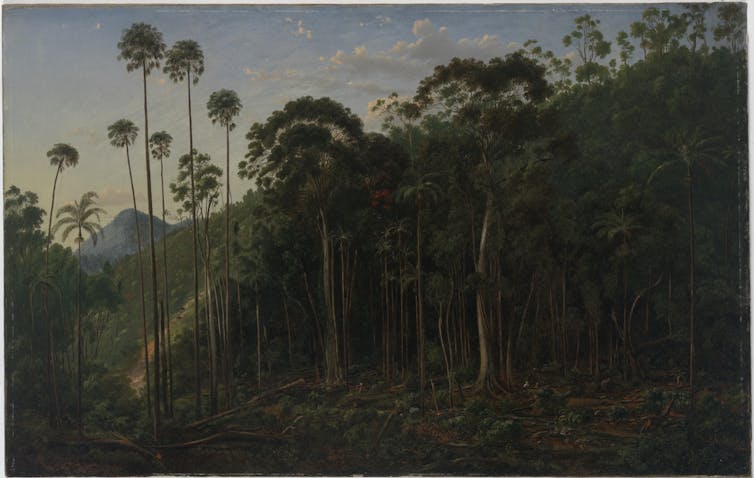 Cabbage Trees near the Shoalhaven River, 1860 painting by Eugene von Guerard.
State Library of NSW
Cabbage Trees near the Shoalhaven River, 1860 painting by Eugene von Guerard.
State Library of NSW
Three towns, the same story
In a regional town museum you will probably encounter some version of the pioneer or settler story. This narrative is illustrated with the many farm tools, pieces of mining equipment, clothes, books, furniture and other domestic and civic artefacts donated by locals over the years.
In this version of history, pioneers move across the land, unencumbered by prior Aboriginal occupants, making it productive as they go. Small museums seem to get stuck in this white pioneer groove.
Historian Amanda Nettelbeck observes that Aboriginal and non-Aboriginal histories are often presented as two separate sides of colonial history, rather than as an obviously connected relationship between British settlement and Aboriginal dispossession.
In the museums of Berry, Kangaroo Valley and Nowra, three towns central to the NSW South Coast tourism economy, the idea of a frontier (that space of conflict over land, resources, rights and sovereignty) is avoided. But how is this achieved, when the pioneer story depends on the frontier for its existence?
Looking at these three museums reveals artefacts of Aboriginal provenance are presented in ways that cast them as either relics of a distant past, symbols of a generic Aboriginality or curiosities with no political context. They celebrate the pioneer without acknowledging the founding dispossession of local Yuin people. Frontiers are messy; pioneers clean things up. And museums keep the story simple, neat and tidy.
Too hot to handle
This is not to say the dedicated volunteers who run these museums come down on one side of the “History Wars”. The staff who care for their collections are often keen to address their lack of information on specific Yuin histories.
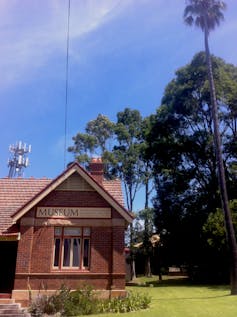 Nowra Museum with nearby cabbage tree.
Jen Saunders, Author provided (No reuse)
Nowra Museum with nearby cabbage tree.
Jen Saunders, Author provided (No reuse)
In 2017, Nowra Museum hosted the travelling exhibition This is where they travelled, which accompanied Paul Irish’s book Hidden in Plain View: the Aboriginal people of coastal Sydney. In the same year, the Berry Museum hosted the Yuin anthropologist, the late Les Bursill, who delivered a lecture on Yuin history of the South Coast. Kangaroo Valley Pioneer Village committee members responded to a draft of this essay, saying they would renew signage in the museum and were keen to pursue new research on local Aboriginal histories.
Despite this, the overwhelming story remains that of white settlers’ hard work and perseverance. And although part of the reason for the static nature of museum stories is lack of funds and a reliance on the time and energy of volunteers, the narrative’s repetitive nature – and its general wear and tear – may also be due to its omissions. Bruce Pascoe reframes the perception of Australian history as boring, by drawing our attention to what’s left out: “Australian history isn’t boring, it’s just too hot to handle.”
The blinkered storyline of small museums is a symptom of what US scholar Mark Rifkin calls “settler common sense”. Settler common sense describes the feeling of “taken-for-granted” possession of, and belonging to, a place which has been taken from someone else.
Settler common sense exists as “a given”: we (as a white person, I include myself) have the unquestionable right to possess that which doesn’t belong to us. It normalises settler possession of, and control over, land and the stories about that land. The pioneer or settler narrative relies on that assumption: white rights to non-white land, and white rights to the telling of history.
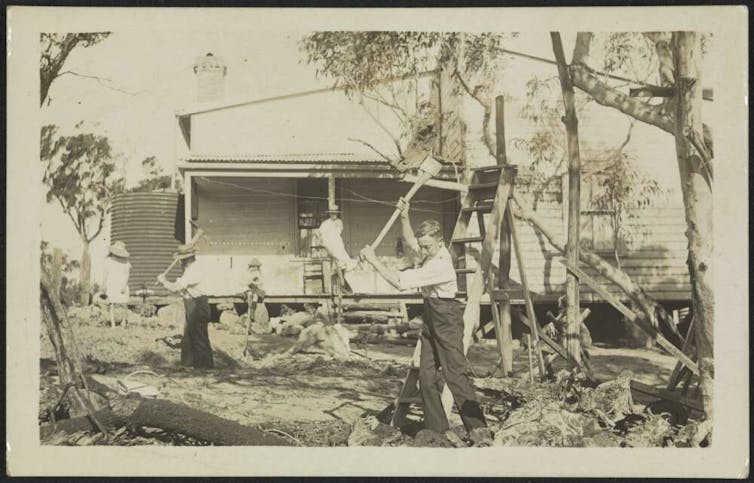 The concept of settler common sense holds white rights to land as a given.
National Library of Australia
The concept of settler common sense holds white rights to land as a given.
National Library of Australia
A place somewhere else
Pioneer Village Museum in Kangaroo Valley, NSW, presents Aboriginal history as far removed from its own backyard.
In one of the cottages in the recreated village hang two bark paintings, donated in the 1970s by a local who acquired them in Arnhem Land. In another cottage is a display case containing miniature souvenir versions of clubs, boomerangs and animal figurines.
Below these are a group of unlabelled grinding stones, which may or may not be from the local region. Labels for other objects in this display read “boomerang made from mulga wood” and “more mulga wood boomerangs” (mulga is a small tough acacia which grows in arid inland regions, not Kangaroo Valley). Other labels read: “replica of an emu egg”; and “fighting weapon could be used to split the enemy’s head open”.
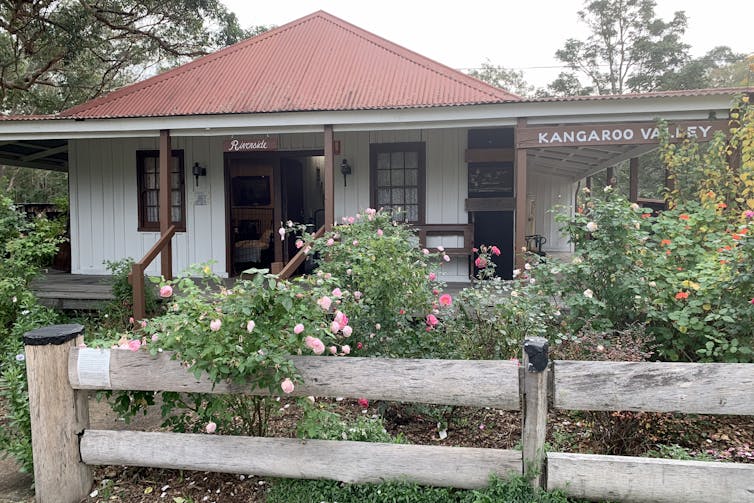 The pioneer narrative is maintained in Kangaroo Valley.
Caroline Berdon/AAP
The pioneer narrative is maintained in Kangaroo Valley.
Caroline Berdon/AAP
These items are presented without context and without any relationship to Kangaroo Valley. They are accompanied by an illustrated word list entitled “Interpreting Aboriginal Symbols” and although the words are indeed Aboriginal, the language is Warrgamay, spoken by people of the Herbert River region of North Queensland.
By presenting objects that are replicas, miniatures, unlabelled or misleadingly labelled, the museum allows a generic “Aboriginality” to be visible while keeping it unrelated to Kangaroo Valley and local people. The presentation does not disrupt the Kangaroo Valley settler narrative because Aboriginal existence is presented as inauthentic and elsewhere.
Other histories about Kangaroo Valley tell a different story. The museum’s own archival sources document the many meetings in the region (albeit from colonial viewpoints) between local Aboriginal people and colonisers during the 1800s and 1900s, the large gatherings at Kangaroo Valley for ceremony and song-learning “for which they sometimes travel far” and the Aboriginal families who relied on work at the four timber mills in the town in the 1940s.
More than portraits
Drive south over the scenic mountain range from Kangaroo Valley and you will cross the Shoalhaven River to Nowra.
As a regional centre, Nowra has several museums to choose from: the Fleet Air Arm Museum for aircraft enthusiasts, Meroogal House Museum for lovers of old houses and domestic interiors, and the town museum run by the Shoalhaven Historical Society.
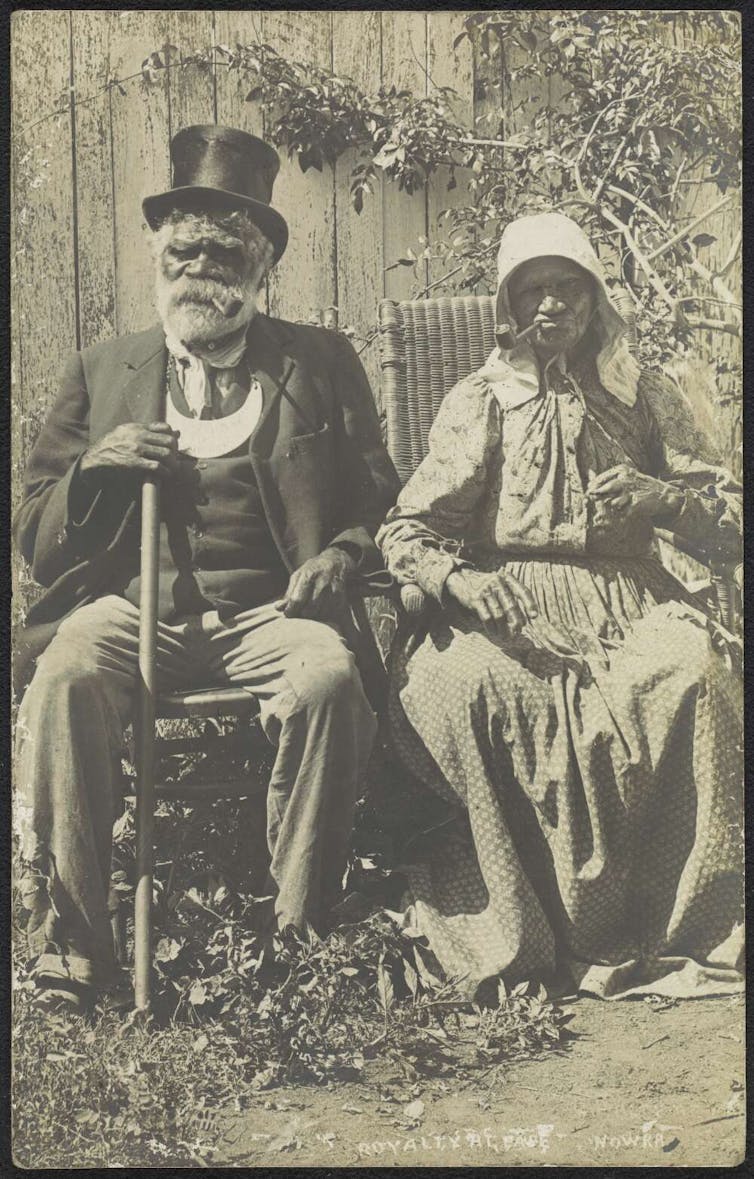 James Goulding and Mary Carpenter, Nowra, New South Wales, approximately 1905.
National Library of Australia
James Goulding and Mary Carpenter, Nowra, New South Wales, approximately 1905.
National Library of Australia
Nowra Museum’s exhibition of local Aboriginal presence is built around a collection of timber and stone artefacts and an impressive black and white photograph of an elderly couple, James Goulding and Mary Carpenter. They are seated on chairs in a garden, and wear European clothing typical of the early 1900s. Goulding, who also wears a top hat, has a ‘breastplate’ suspended from a chain, around his neck.
In a display case near the photograph, is a brass breastplate engraved with the name “Neddy Noora” and “Shoal Haven 1834”. Alongside this is a reproduction of a drawing that was part of a series of portraits of Aboriginal ‘kings’ and their wives done in Sydney by German-born Charles Rodius, in the early 1830s. The portrait shows the young Neddy Noora, wearing the breastplate over his European clothing.
The granting of breastplates to Aboriginal people signified a reward given for assistance or rescue and they were an attempt at gaining influence over individuals thought to be leaders.
Read more: A breastplate reveals the story of an Australian frontier massacre
Aboriginal recipients also had a stake in these tactics, no doubt being well aware of the hierarchies so blatant in colonial society. Offered as a status symbol, acceptance was the “gracious and prudent thing to do”. However, by the end of the 1800s, breastplates lacked political currency and became prized by white collectors.
Entangled
Engraved on the breastplate James Goulding wears are the words “Budd Billy King of Jarvis Bay” (sic). Budd Billy is an Anglicisation of Goulding’s Aboriginal name Budbili. Ngarigu linguist Jakelin Troy gives the meaning of budbili as “possum-skin rug”.
This single word from the Dharawal language of the Yuin nation, links a person and a place with important historical and cultural objects – a pre-colonial possum-skin rug and a colonial metal breastplate – both of which existed within the tangled cultures of the pre and early post-Federation era.
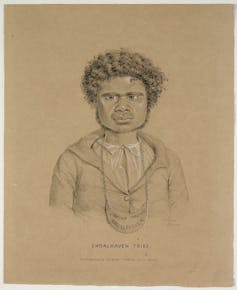 A portrait of Neddy Noora by Charles Rodius.
Mitchell Library/State Library of NSW
A portrait of Neddy Noora by Charles Rodius.
Mitchell Library/State Library of NSW
The breastplate given to Neddy Noora was found in Broughton Creek (near the town of Berry) in 1925. Neddy and another Aboriginal man, Toodwit (also known as Broughton), guided John Oxley’s expedition to mark an overland route between Sydney and Jervis Bay in 1819. Toodwit was central to Alexander Berry’s 1822 reconnoitre of the region.
Nowra Museum’s display has been updated recently to include a brief explanation of the political aspect of giving and receiving breastplates and when I contacted Lynne Allen, president of the Shoalhaven Historical Society, she explained that museum volunteers can provide visitors with an explanation of breastplates as a European construct.
She said that the large portrait of Mary Carpenter and James Goulding was “consistently amongst our visitors, Aboriginal or otherwise, the most popular of all our items”.
Does this popularity translate into greater awareness of our complex local histories? The people in these portraits are not just entangled with the white cultures that entered their lands but are linked to Yuin descendants today.
Quaint and charming
Heading north, back to the city, you will again pass through Berry, advertised to tourists as an historic village with “the perfect blend of village charm and city style” that is “full of interesting history”.
Berry Museum plays its part, presenting Alexander Berry as a soft-hearted adventurer yet hard-headed businessman, who was distressed by any form of human suffering. His interest in phrenology and trade in the skulls of Aboriginal people is not mentioned in Berry Museum.
In 1822, Berry and his business partner Edward Wollstonecraft were granted 10,000 acres on the Shoalhaven River by Governor Sir Thomas Brisbane. This possession of a vast section of Yuin land, renamed Coolangatta, gave Berry access to Aboriginal graves.
Collection of human skeletal remains, particularly skulls, was not uncommon in colonial societies. Berry and Governor Brisbane shared an interest in phrenology (the study of skull shape), and Brisbane donated a “skull of a native female of New South Wales” to the Phrenological Society of Edinburgh.
During the 1820s Berry also actively sought out skulls from associates in Tasmania. In 1827, in a letter accompanying a “craniological specimen”, Berry describes Arawarra, “the owner of the present specimen”, as a “once formidable warrior”, being carried by his son to “take a last look of Cooloomgatta (sic) now occupied by strangers”.
Berry describes how the “venerable old gentleman” died two days after this meeting and was buried on the Coolangatta estate. He goes on to describe the manner of Arawarra’s burial, stating that he “lived to an extreme old age and died in peace”.
The tourist space
Historian and cultural studies scholar, Katrina Schlunke, asks “what can and can’t be said in ‘tourist space’?”. Vandalisation of burial sites and collection of skulls does not fit with the image of Berry as a relaxing country getaway. And including the story of Arawarra carelessly may risk further desecration of Yuin protocols if not undertaken with extensive consultation with Elders and community members.
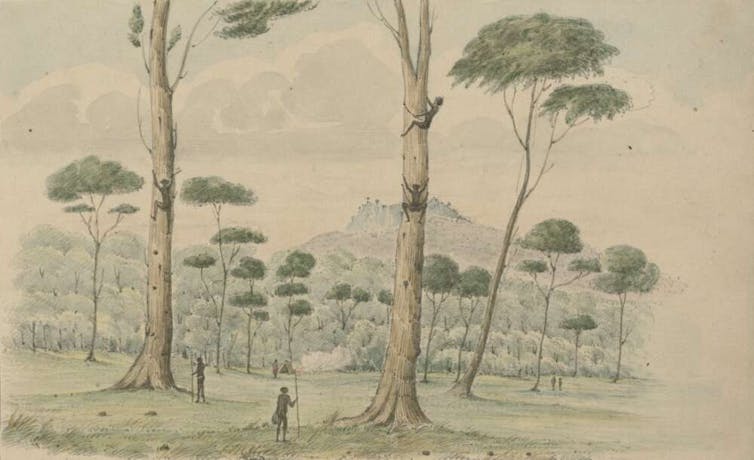 Robert Marsh Westmacott’s picture depicting the ‘View in the Kangaroo Valley showing the manner the Natives climb the trees for opossums and bandicoots’.
National Library of Australia
Robert Marsh Westmacott’s picture depicting the ‘View in the Kangaroo Valley showing the manner the Natives climb the trees for opossums and bandicoots’.
National Library of Australia
Museums have never been neutral in the choices they make about what to display and how, but avoiding traumatic or difficult histories is not neutral either.
Wiradjuri curator at the Australian Museum, Nathan Sentance, states that museums and archives “should not just work to document bad history, but work to prevent bad history from happening”. Including the “bad” history of the town of Berry may work towards a better understanding of how replacing the bush and swamps greatly benefited some people at the ongoing expense of others.
Reinterpreting local histories is not for the fainthearted and the more the “top” layer of the pioneer story is disrupted, the more the “too hot to handle” stories emerge.
The Berry District Historical Society’s website claims, “the complete story of Alexander Berry is full of adventure and courage”. This pitch tells us there is some serious reconsideration needed regarding what constitutes a “complete” story.
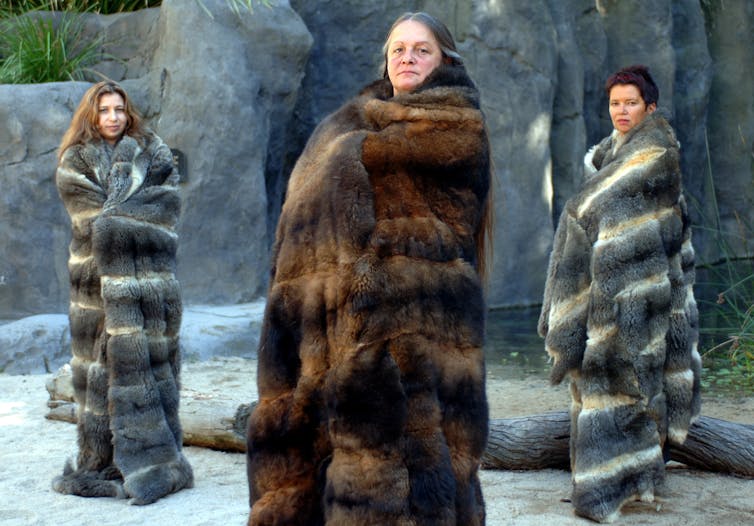 More than a decade ago, Melbourne Museum displayed possum coats made by Koori women in an exhibition that connected modern visitors to Indigenous traditions.
Julian Smith/AAP
More than a decade ago, Melbourne Museum displayed possum coats made by Koori women in an exhibition that connected modern visitors to Indigenous traditions.
Julian Smith/AAP
History is messy
In 2018, the 10-Year Indigenous Roadmap, commissioned by peak body Australian Museums and Galleries Association, was finalised. The aim of the roadmap is to change “interactions, communication, understandings and ultimately, the Australian view of First Peoples”.
Small museums, with their wealth of material, stories, experience and passionate volunteer staff, could play an important part in achieving that aim.
Megan Davis, Cobble Cobble woman, Pro Vice Chancellor and Professor of Law at UNSW, reported that in the dialogues conducted in preparation for the Uluru Statement from the Heart, the overwhelming view was that “a nation cannot recognise people they do not know or understand”.
The truth-telling the Uluru Statement calls for, could be work that local museums, in partnership with Aboriginal communities, could contribute to in ways that profoundly reinvigorate how local histories get told.
Authors: Jen Saunders, Phd candidate, University of Wollongong
Read more http://theconversation.com/small-histories-a-road-trip-reveals-local-museums-stuck-in-a-rut-113104





